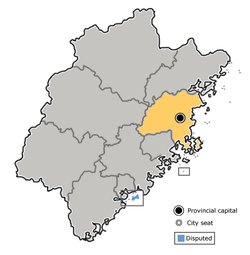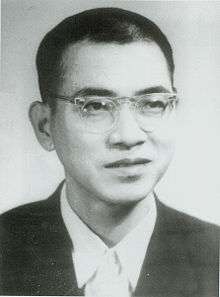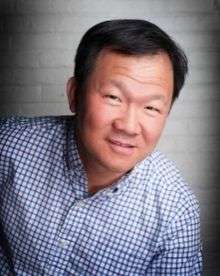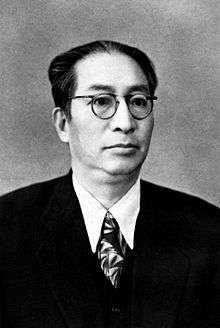Fuzhou people
| |
|---|---|
|
Hockchew women in Bible Women's Training School during a women's class in Fuzhou, 1873. | |
| Total population | |
| ~10,000,000[1] | |
| Regions with significant populations | |
| Languages | |
| Fuzhou dialect and Fuqing dialect | |
| Religion | |
| Predominantly Mahayana Buddhism and Chinese folk religions (including Taoism, Confucianism, ancestral worship and others), with many non religious. Minority: Christianity | |
| Related ethnic groups | |
| Putian people, Hoklo people, Northern Min speakers, Fuzhou Americans and other Han Chinese |
The people of Fuzhou (Chinese: 福州人; Foochow Romanized: Hók-ciŭ-nè̤ng), also known as Fuzhounese, Foochowese, Hokchew, Hokchia, Hokchiu, Eastern Min or Mindong usually refers to people who originate from Fuzhou region and the Mindong region, adjacent Gutian County, Pingnan County, in Fujian province of China and in the Matsu Islands of Taiwan (Republic of China). Fuzhounese are Han Chinese people and are a part of Min-speaking group, who speaks Eastern Min or specifically Fuzhou dialect. There is also a significant overseas Foochowese population, particularly distributed in Malaysia, Indonesia, Singapore, United States (Fuzhou Americans), Japan, United Kingdom, etc.[2]
Despite their small population size, Fuzhounese people have produced a considerable number of achievements in the science field, such as Zhang Yuzhe (the father of modern Chinese astronomy), Guo Kexin (the main pioneer of electron microscopy of China), Chih-Tang Sah, Hsien Wu, Guo Kexin and Min Zhuo.

Language
Fuzhou dialect is a tonal language that has extensive sandhi rules in the initials, rimes, and tones. These complicated rules make Fuzhou dialect one of the most difficult Chinese varieties.[3]
During the Second World War, some Japanese scholars became passionate about studying Fuzhou dialect, believing that it could be beneficial to the rule of the Greater East Asia Co-Prosperity Sphere. One of their most famous works was the Japanese-Chinese Translation: Fuzhou Dialect (日華對譯: 福州語) published in 1940 in Taipei, in which katakana was used to represent Fuzhou pronunciation.
Many non-speakers have noticed on the 'cuteness' of Fuzhou dialect when they listened to it.
Emigration and diaspora

History
Fuzhou's history of emigration began since the Ming dynasty with Zheng He's voyages overseas. As the result of immigration of Fuzhouese to southeast Asia, Fuzhou dialect is found in Singapore, Malaysia and Indonesia. The city of Sibu of Malaysia is called "new Fuzhou" due to a large wave of Fuzhounese immigration in the early 1900s. They are referred to as "Hockchiu" or "Hokchew" in Singapore and Malaysia.[4]
Southeast Asia
The Hockchius and Hockchias migrated to Nanyang (South-East Asia) in smaller numbers compared to the Hokkien, Cantonese, hakkas and Hainanese but achieved remarkable success. Amongst others, Robert Kuok (Hockchiu) rose to become the "Sugar King" of Malaysia and is currently ranked the richest man in south-east Asia[5] whereas Liem Sioe Liong (Sudono Salim) who was of Hockchia origin, was once the richest man in Indonesia, controlling a vast empire in the industry of flour, cement and food manufacturing.[6] The famous leader of the Malayan Communist Party, Chin Peng was also Hockchia.[7]
United States
Fuzhounese people first started immigrating to America during the late Qing dynasty. Some of these immigrants were students who, after completing their studies returned to back to their fatherland (Fuzhou).
After the lifting of emigration restriction from the People's Republic of China in the 1980s, a small wave of Fuzhounese settled in America. These new Fuzhounese immigrants set up their own separated communities such as "Little Fuzhou" in Manhattan, away from other non-linguistically related Chinese people.
Notable Fuzhounese people
Scientists, mathematicians and inventors
- Yan Fu, a Chinese scholar and translator, best known for introducing western ideas such as Darwinian evolution.
- Hou Debang, a chemical engineer.
- Hsien Wu, a Chinese protein scientist who was the first to propose that protein denaturation was a purely conformational change, corresponded to protein unfolding and not to some chemical alteration of the protein.
- Zhang Yuzhe, a Chinese astronomer who is widely regarded as the father of modern Chinese astronomy.
- Chia-Chiao Lin, a mathematician and Institute Professor emeritus at the Massachusetts Institute of Technology.[8]
- Tung-Yen Lin, a structural engineer who was the pioneer of standardizing the use of prestressed concrete.
- Deng Xuquan, a scientist expertising in microbiology, he served in many universities as both a researcher and lecturer.[9]
- Wang Shizhen, Father of Chinese nuclear medicine.
- Wu Mengchao, widely considered to be the Father of Chinese Hepatobiliary Surgery, for his achievements he was awarded China's highest scientific prize in 2005 by President Hu Jintao.
- Guo Kexin, an important Chinese physicist, metallurgist and crystallographer who is considered as the main pioneer of electron microscopy of China.
- Chih-Tang Sah, Graduate Research Professor at the University of Florida, USA from 1988. Professor of Physics and Professor of Electrical and Computer Engineering.
- Chen Jingrun, a widely known mathematician who invented the Chen's theorem and Chen prime.
- Liu Yingming, a mathematician and academician.
- Sun Shensu, a geochemist and Ph.D holder from the Columbian University (1973).
- Chen Zhangliang, a Chinese biologist, elected as vice-governor of Guangxi in 2007.
- Min Zhuo, a famous pain neuroscientist at the University of Toronto in Canada, he won many prestogious awards for his outstanding scientific achievements.
 Yan Fu, a scientist who translated many of Charles Darwin's works and ideas into Chinese.
Yan Fu, a scientist who translated many of Charles Darwin's works and ideas into Chinese. A famous protein scientist, Hsien Wu was the first to propose that protein denaturation was a purely conformational change.
A famous protein scientist, Hsien Wu was the first to propose that protein denaturation was a purely conformational change. Mathematics genius, Chen Jingrun invented the Chen's theorem and Chen prime, he also stunned famous mathematicians by providing better solutions to their works.[10]
Mathematics genius, Chen Jingrun invented the Chen's theorem and Chen prime, he also stunned famous mathematicians by providing better solutions to their works.[10] Min Zhuo, being an accomplsihed pain neuroscientist, he has won many honours and awards.
Min Zhuo, being an accomplsihed pain neuroscientist, he has won many honours and awards.
Politicians and revolutionaries
- Shen Song, a chancellor of the state Wuyue during the Five Dynasties and Ten Kingdoms Period.
- Chen Di, famous Ming era philologist, strategist and traveler.
- Lin Zexu, a prominent Chinese scholar and official, widely regarded as a Chinese national hero for his strong opposition to the trade of opium before the First Anglo-Chinese War.
- Shen Baozhen, Viceroy of Liangjiang from 1875 to 1879.
- Chen Baochen (陈宝琛, 1848 - 1935), Chinese scholar and loyalist to the Qing Dynasty.
- Wong Nai Siong, a Chinese revolutionary leader and christian scholar.
- Chen Jitong, Chinese diplomat, general and scholar during the late Qing dynasty.
- Lin Shu, Chinese scholar and translator, noted for his translation of Alexandre Dumas and La Dame aux Camélias.
- Zheng Xiaoxu, Chinese statesman, diplomat and calligrapher.
- Liu Guanxiong, Chinese Admiral who was Navy Minister of China, from 1912–1916 and 1917-1919.
- Lin Sen, President of the Republic of China from 1931 to 1943
- Lin Xu (林旭, 1875 - 1898), Chinese politician, scholar, songwriter and poet who lived in the late Qing dynasty.
- Du Xigui (杜錫珪, 1875 - 1933), Chinese admiral during the warlord era.
- Lin Juemin (林觉民, 1887 - 1911), Chinese revolutionary, member of Tongmenghui in Japan.
- Chin Peng, OBE, the Former leader of the Malayan Communist Party
- Ling Liong Sik, a Chinese Malaysian]] politician; former president of the Malaysian Chinese Association and former Minister of Transport.
- Ngeh Koo Ham, a Chinese Malaysian politician and lawyer.
- Nga Kor Ming, a Chinese Malaysia politician of Democratic Action Party (DAP), Member of the Malaysian Parliament of Taiping, Perak since 2008.
 Lin Zexu, national hero of China.
Lin Zexu, national hero of China. Lin Sen, the former President of the Republic of China.
Lin Sen, the former President of the Republic of China.- Lin Xu, a writer and political reformer of the late Qing Dynasty.
 Wong Nai Siong, prominent Qing era revolutionary leader.
Wong Nai Siong, prominent Qing era revolutionary leader.
Writers and poets
- Ingen, well known Buddhist monk, poet and calligrapher who lived during Ming Dynasty.
- Zou Taofen, Chinese patriot, journalist, media entrepreneur, and political activist.
- Zheng Zhenduo, a Chinese journalist and literary scholar
- Zhu Qianzhi, a Chinese intellectual, translator and historian.
- Bing Xin, a female Chinese writer.
- Hu Yepin, left wing writer.
- Zheng Min, Chinese scholar and poet.
- Wang Wenxing, Chinese American writer.
- Watchman Nee, a Chinese Christian author and church leader

 Zheng Zhenduo, master of literature.
Zheng Zhenduo, master of literature.
Businessmen
- Liem Sioe Liong, a Chinese Indonesian billionaire businessman and founder of Salim Group
- Robert Kuok, a Malaysian billionaire businessman and chairman of Shangri-La Hotels and Resorts
- Surya Wonowidjojo (Tjoa Ing-hwie), the founder of Gudang Garam, the largest cigaret producer in Indonesia.
- Rachman Halim, second CEO of Gudang Garam.
- Tiong Hiew King, a Malaysian Executive Chairman of Rimbunan Hijau, Timber tycoon and Chinese Media proprietor.
- Tiong Thai King, a Malaysian politician and businessman, Member of the Malaysian Parliament for Lanang, Sibu, Sarawak from 1995-2013.
- Alim Markus, Indonesian businessman from East Java.
Others
- Wu Qingyuan, a Chinese Weiqi/Go player, considered by many players to be the greatest player of the game in the 20th century and one of the greatest of all time.
- Jahja Ling, a famous Orchestra conductor.
- Lin Huiyin, a female Chinese architect and wife of architect Liang Sicheng.
- Lin Yaohua famed Chinese sociologist and anthropologist.
- Nicholas Kao Se Tseien , the oldest living Catholic priest in China and Hong Kong.
- Cheng Nan-jung, a Taiwanese publisher and pro-democracy activist.
- Ludi Lin, an actor who starred in the 2017 Power Rangers.
See also
- Fuzhou, the homeland of Fuzhou people.
- Fuzhou dialect, the native mother tongue of Fuzhou people.
- Fuzhou Americans, a portion of the Fuzhounese diasopa.
References
- ↑ "Peoples Listing: MinDong People". Joshua Project. Retrieved 2009-10-18.
- ↑ 福州市志(第八册). 方志出版社. December 2000. ISBN 7-80122-605-4.
- ↑ Khoon Choy Lee. Pioneers of Modern China: Understanding the Inscrutable Chinese. World Scientific. p. 20. ISBN 98-127-0090-0.
- ↑ Chinese Overseas: Comparative Cultural Issues. Hong Kong University Press. p. 92.
- ↑ Leo Suryadinata (2006). Southeast Asia's Chinese Businesses in an Era of Globalization: Coping with the Rise of China. Institute of Southeast Asian Studies. p. 184. ISBN 98-123-0401-0.
- ↑ Timothy Brook & Hy V. Luong (1999). Culture and Economy: The Shaping of Capitalism in Eastern Asia. University of Michigan Press. p. 163. ISBN 04-720-8598-0.
- ↑ Jessieca Leo (2015). Global Hakka: Hakka Identity in the Remaking. BRILL. p. 291. ISBN 90-043-0027-9.
- ↑
- ↑ "邓叔群". dangan.njau.cn.
- ↑ Genius At Play: The Curious Mind of John Horton Conway. p. 62.
| Wikimedia Commons has media related to Fuzhou people. |
_(14763995591).jpg)